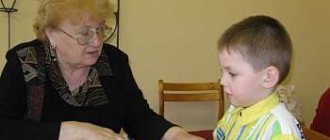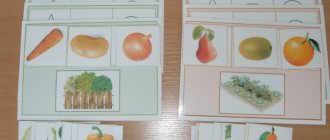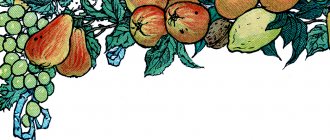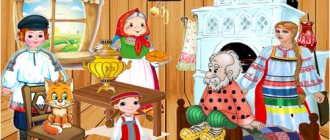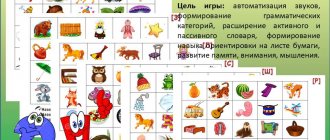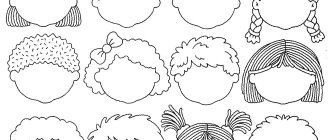The simplest mnemonic techniques for children in grades 1-4
Young children in elementary school are still developing voluntary memory. Will in this process is the main thing. When a child needs to make an effort and will to remember.
You can read more about the types of memory in the article Development of memory and attention in preschool children - the best games and exercises (opens in a new tab).
And since volitional memorization is still being formed, it is necessary to use fun and funny methods.
The easiest way is rhyme and rhythm
Here, however, it is worth warning that this method does not mean understanding the memorized information.
Rhythm. We use this method without even noticing it. We repeat information with a certain rhythm, thereby remembering it. Musicians may appreciate this method.
We also automatically create a rhyme or use an existing one. This is how you can learn the multiplication table.
- Six six is thirty six.
- Five five is twenty five.
- Six eight is forty eight.
- Six four twenty four.
My daughter and I found multiplication so interesting: 7x8=56. 5 and 6 are the two previous numbers going up to 7 and 8. That’s what we say: “7, 8, 5, 6.”
Dates and numbers
There is the most effective way to remember numbers and dates. This is a method of bringing numbers to life and creating stories with them.
But before using the method, you and your child need to use your imagination and come up with what each number looks like? The image of the same number on each specific date may be different.
You can use these tips.
Where will the regroupings lead?
Grouping is breaking down information into smaller parts or highlighting smaller parts for better remembering.
Couples
If we need to remember a long number, we can break it into pairs. For example, you need to remember the phone number: 50482793. Break it down and get: 50 48 27 93
Even just reading a long number helps children by breaking it down into familiar components.
For example, you need to read the number and remember it: 25,000,000. The child knows the ranks of numbers, that 1,000 is a thousand, and 1,000,000 is a million. Each digit has 3 digits.
We break the number from the end into three digits: 25,000,000. The total number of 2 full digits is a million. We read the number to the left of 6 zeros (million) - 25 and add millions.
In pairs and threes we reduce the amount of information that needs to be remembered and make the process easier for ourselves.
Acronyms
This is a certain type of abbreviation. They are formed from the initial letters of words and are pronounced together, not letter by letter. KGB is not an acronym.
That is, in other words, we use the initial letters of the memorized word to create other words that are understandable and easy for us.
The goal is to give words a different meaning and facilitate the memorization process. The well-known word “university” is an institution of higher education. It's an acronym.
For example, you need to remember the names of the parts of speech: verb, noun, adjective. We take the first few letters of each word and get an unexpected, almost medicinal word:
GLASUPRIL
Try it yourself.
Or you can make up a whole story from the initial letters of words. Remember how you taught your child to remember the names of the sequence of colors in the rainbow?
Every (red) Hunter (orange) Wants (yellow) to Know (green) Where (blue) Pheasant (purple) Sits.
This is also a mnemonic device.
These scary sequential associations
In fact, this is just a scary long method name)
Sequential associations are used to remember a list of words and their order. In this technique, an association is selected for each word and specific associations are remembered, not words.
For example, a cup, a bear, an airplane, a broom.
— I see a cup that a bear is trying to get into. He finally gets into it. The cup stretches and turns into an airplane that flies between the broom rods.
But! It is important not only to come up with connections between objects, you need to form a mental image, see each image in action. First imagine a cup. What is she like? What color, shape?
Then we introduce the bear. What is he like? Like in life or like in the picture? Imagine the color of your fur coat and eyes. Are the claws long? Then we connect the images.
We imagine a bear getting into a cup. You need to see it in your mind and take your time. Let the images come to life. This big bear climbs into the cup.
She is so small, but the bear is huge. First he lowers one leg, then the other. And now he is already sitting there.
The cup stretches, the spout turns into the nose of an airplane, the sides also stretch out and turn into airplane wings, then a tail appears. And now our plane is flying.
And on the way, a huge broom appeared, and our airplane maneuvers between the bars so as not to touch them and crash.
Having imagined this picture, the child will easily remember the words that he memorized.
The mere creation of visual associations by a child not only trains the ability to remember, but with the help of this tool one can remember a lot.
In addition, we connect our right hemisphere, imagination, visualization, which also develops thinking.
Scribbles?
Why kalyaki-malyaki? Because we will use graphic associations.
It is necessary to depict the memorized information graphically, using drawing tools. You write a word and artistically highlight the letter you need to remember. How to highlight graphically?
We need to remember the spelling of the word Carrot. We write Carrots. Moreover, “O” can be of enormous size. You can draw a face in the letter “O” that shows the tongue.
You can draw a car wheel, or you can draw a cucumber. Or you can simply “scribble” the letter “O” and put a blot on it. This will definitely be remembered.
This is a very creative task and the child himself will tell you what needs to be done)
Let's play with sound?
Scientifically, we use phonetic associations. I'll just give an example.
Bullfinch and snow - some kind of laughter
They don't look alike at all
But the letter e is in the word snow,
And in the bullfinch too!
Phonetic associations can be used to learn foreign words. To do this, it is necessary to select consonant associations of Russian words with foreign words and form an image.
Puddle in English is pronounced puddle. The consonant Russian word is to fall. We imagine a boy falling into a puddle. Or Peppa Pig. She loved to fall into a puddle)
Is this seat taken?
Method "Places or locations". This method is also called the Cicero method. It is the oldest and became popular half a century before the birth of Jesus Christ.
Cicero told the story of a poet who had to remember guests based on where they were sitting at a dinner party before the roof collapsed. Their bodies could not be identified. And the poet remembered them by the place where each one sat.
This experience was evidence that a person can improve memory abilities by forming mental associations with a specific place.
Using this method, it is necessary to place words or blocks of information, translated into images, in known places in the room or house. Then mentally walk through them and remember the information.
This is how Greek and Roman orators prepared their speeches, and they also used this method to conduct long discussions.
If a child needs to remember something, let’s say learn a paragraph from a textbook. What are we doing?
We allocate 5 places: kitchen, living room, bedroom, bathroom, toilet. For placement, it is necessary to divide the memorized material into blocks. If there is a retelling plan, then we divide the material according to the plan.
Next, you need to come up with your own images for each block and link them to the corresponding place in the apartment, or to a specific place in your room.
For example, you need to remember the paragraph about the forests of Russia. In the kitchen we will arrange the taiga with its coniferous forests.
We enter the kitchen, and there is a continuous green forest along the walls and it smells of pine needles, fir trees, larch trees, one of them accidentally pricked a child’s hand.
Yes, we must not forget about the animals that sit under the fir trees and on the branches of the pine trees. We place them there according to the list. Some growl, others let themselves be petted, and others simply fly to another tree.
Let's go further and place information in the living room with images. The living room will have mixed woods. Between the fir trees, pines and larches we see birch trees, etc.
After placing the images in the appropriate rooms, we need to go through our place-rooms again to remember the information.
How to learn poems dynamically?
Using the “Places” method you can learn poems and rules. For example, reading a line of a poem in one room, walking around it, connecting this line with objects in the room.
Then go to another room and recite the next line, etc. Learn each line in a specific room.
When memorizing, you don’t have to physically walk, but walk mentally, in your imagination, from one room to another.
Another option. Do not walk from room to room, but while sitting in one room, simply turn around and look from one object to another as you pronounce each line.
For example, learn a line if you memorize in the room and watch the TV. Learn the second line and look at the sofa, etc.
Or do all this in your imagination - mentally move your gaze from one object to another while memorizing the next line.
Having memorized the entire poem, leave the room, and then enter, mentally repeating what you have memorized and using the same associations.
Where should I hang the word?
Words of support or words-hangers
This technique is an improvement on the previous technique "Places". It was invented in the 18th century by Henry Herdson. It allows you to remember unrelated information.
First you need to prepare hanger words. For example, 1 is a jump, 2 is a juice, 3 is a cough, 4 is a box, 5 is legs, etc. As much as you need to remember.
Next, we hang the information that needs to be remembered on hangers. How?
It is necessary to select an association between the memorized information and words - hangers. As a result, we should get a mental image in which new information and the hanger word interact.
The image should be lively and very detailed.
For example, we need to remember the words: table, dog, tree. We present:
1 - jump. Jumping up and down table
2 - juice. A dog drinking juice from a straw
3 - cough. A tree coughing or bending over to clear its throat.
The funnier the image, the better it will be remembered.
We encrypt information
Yes, we just translate the information not into codes, but into schemes. We conveniently place the diagrams in tables and get mnemonic tables.
With the help of schematic graphic images, you can memorize various types of information: poems, rules, texts, fairy tales.
Mnemonic tables are a graphic image (drawing) - a diagram of a memorized word, action, phrase. We depict the entire poem, story or text in the form of diagrams that the child can easily remember.
Methodological manual “Using mnemonics for memorizing poems”
“Using mnemonics to memorize poems”
Abstract to the methodological manual “Using mnemonics for memorizing poems”
The manual is intended for preschool teachers and parents; it contains mnemonic tables for memorizing poems with children of all age categories, recommended by the Standard Educational Program for Preschool Education “Growing Personality” / Author-comp. Arutyunyan L.N., Sipacheva E.V., Makeenko E.P., Kotova L.N., Mikhailyuk S.I., Bridko G.F., Gubanova N.V., Kobzar O.V.,
Relevance:
One of the main tasks of raising and teaching preschool children is the development of speech and verbal communication. The main and distinctive feature of modern society is the replacement of live human communication with dependence on the computer. The problem of developing children's coherent speech is well known to a wide range of teaching staff. Knowledge of your native language is not only the ability to construct sentences correctly. Children master their native language through speech activity, through speech perception and speaking. That is why it is so important to create conditions for children’s well-connected speech activity, for communication, for expressing their thoughts. However, as practice shows, despite the increased interest in the problem, the level of speech development of preschool children is insufficient. Visualization is one of the basic didactic principles of pedagogy. Actions with objects and their visual perception are the first stage in the development of a child’s thinking, so it is important to use visual material throughout the entire process. Recently, mnemonic techniques have been widely used in pedagogical practice to teach storytelling to preschool children.
Mnemonics or mnemonics, translated from Greek - “the art of memorization” - is a system of methods and techniques that ensure effective memorization, successful acquisition by children of knowledge about the characteristics of natural objects, the world around them, effective memorization of the structure of a poem, preservation and reproduction of information, and of course development speech.
When memorizing poems with children, the teacher (parent) faces two tasks:
1. Achieve good memorization of the poem.
2. Teach children to read a poem expressively.
Expressive reading requires literal knowledge of the text, because omitting or changing the order of words violates the music of the work, its artistic form. To simplify the memorization of poems, teachers use various techniques, but one of the most effective is mnemonics. The fact is that in preschoolers, involuntary memorization is much more successful than voluntary. Children remember simply because some object or phenomenon came into their field of vision. It is difficult for a child to remember something abstract, so information for memorization must be supported by a visual picture (mnemonic table). The child reproduces the entire poem from memory, using a graphic image.
Principles of operation of mnemonic tables
Note that to encode a poem, even the simplest image for a line or an entire quatrain is sufficient. It is not necessary to be a professional artist to depict the objects or actions described in the work. In a mnemonic table it is possible to schematically display the entire world around us: natural phenomena, events, signs of objects, actions of characters. The method of mnemonic tables has been developed in detail, with the necessary instructions, which does not cause difficulties in application.
The scope of the article does not imply an extended description of the methodology, so we will focus on its main principles. Work begins with the construction of a mnemonic square that corresponds to a specific word. For example, the poem “White Birch” by Sergei Yesenin is memorized. Using the word “birch,” the teacher suggests considering the symbolic designation of a tree. This should be a simple and accessible drawing for children that they can complete on their own. Then we do the same with other words, for example, “window”, “snow”, “branches”, etc. So children begin to gradually understand what the symbol of the word means.
At the beginning of training, colored mnemonic tables are offered, since color images quickly appear in children’s memory: snow is white, spruce branches are green, the sky is blue. Then, as specific skills in depicting objects are mastered, black and white symbols are used so as not to be distracted by their brightness.
Subsequent work on the poem involves a gradual transition from mnemonic squares to mnemonic tracks, which designate entire poetic phrases. This is how the poem is gradually memorized and reproduced using conventional symbols.
After mastering the necessary initial knowledge about symbols, children are led to actions with mnemonic tables. The number of cells in the table depends on the complexity and size of the text, as well as on the age of the students. Thus, the entire poem is recorded schematically.
Teachers note that as they learn, children are actively involved in creating their own scheme. After this, they reproduce the entire text from memory, using only a symbolic image.
